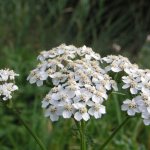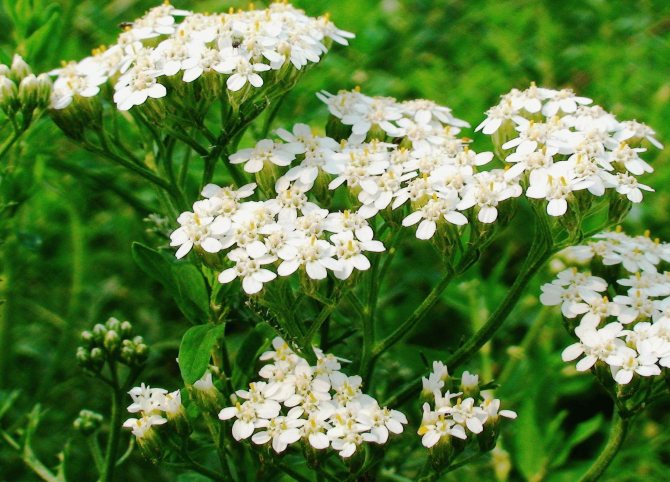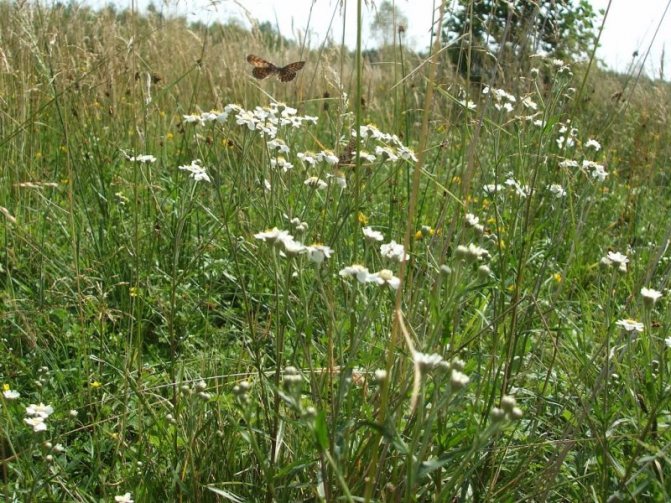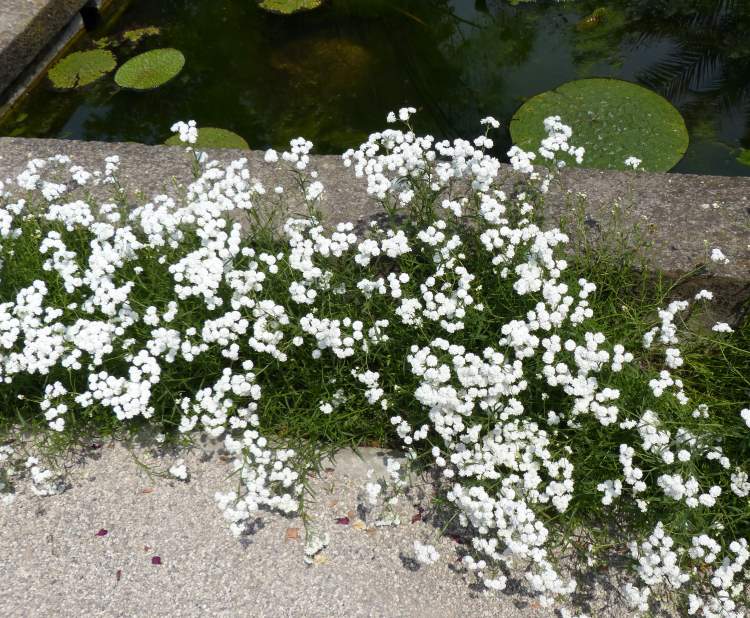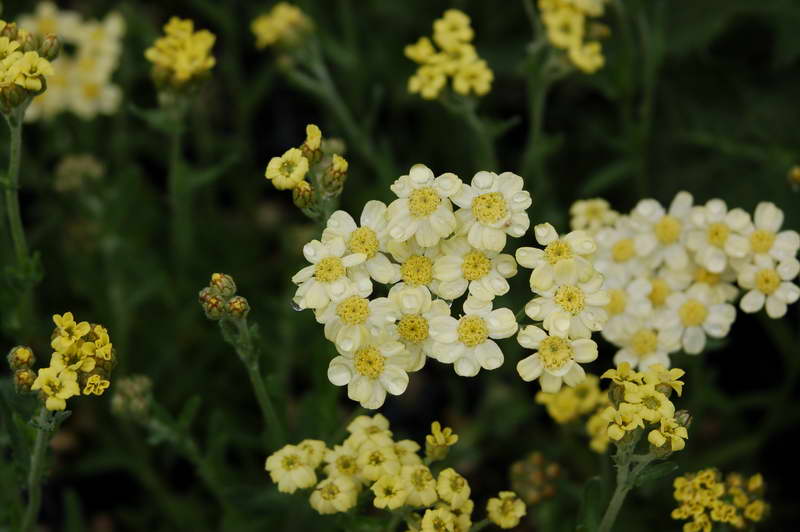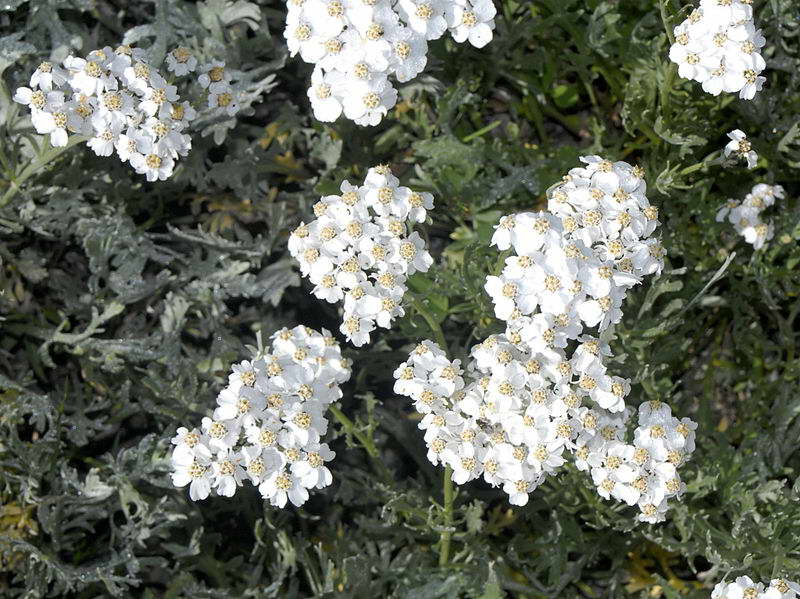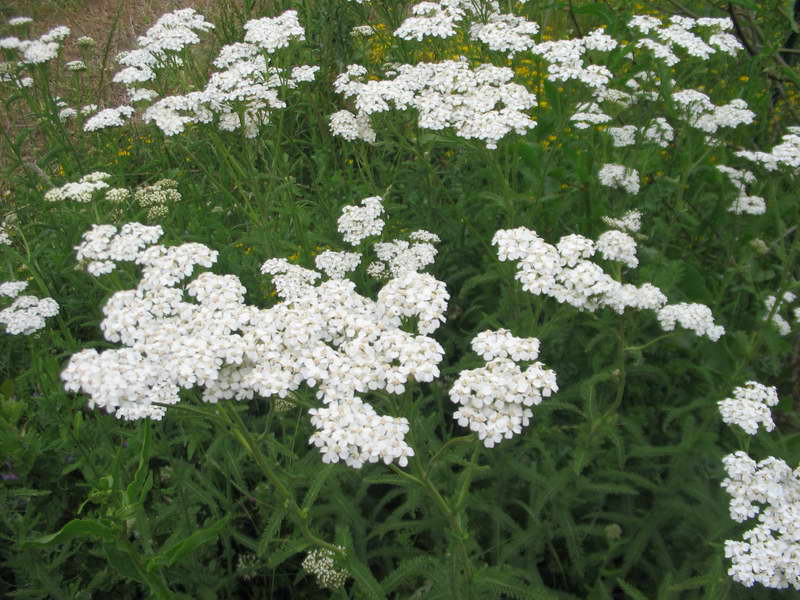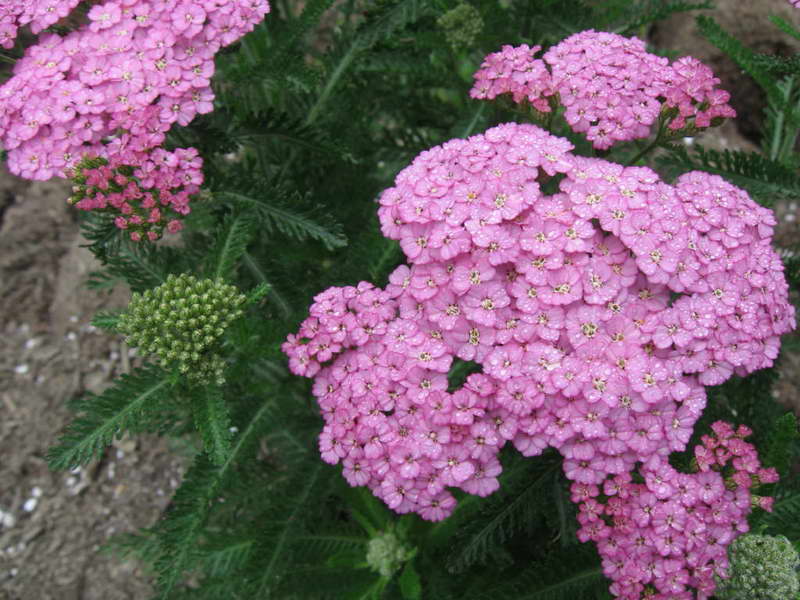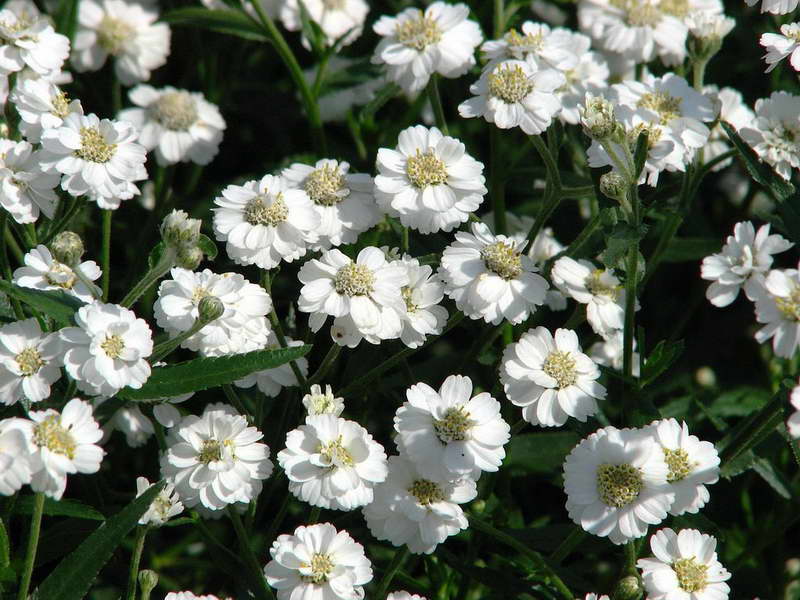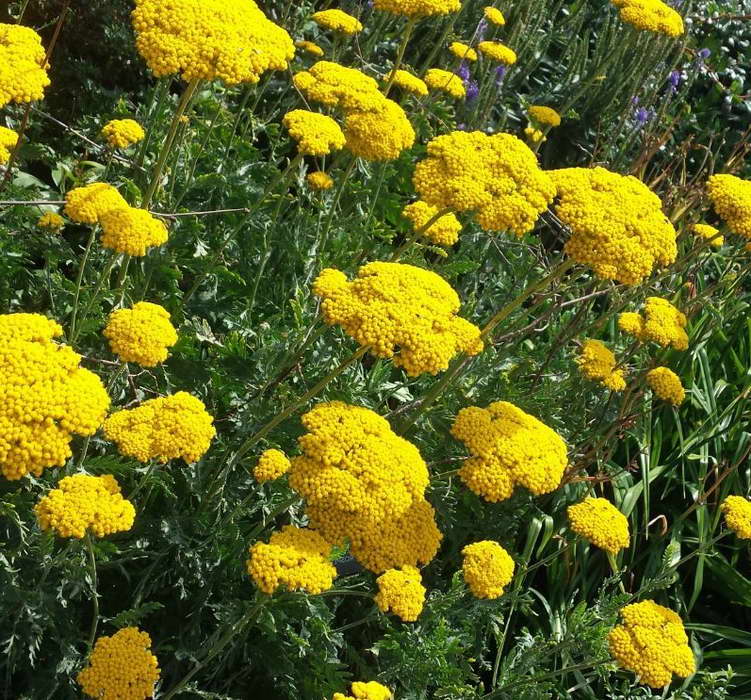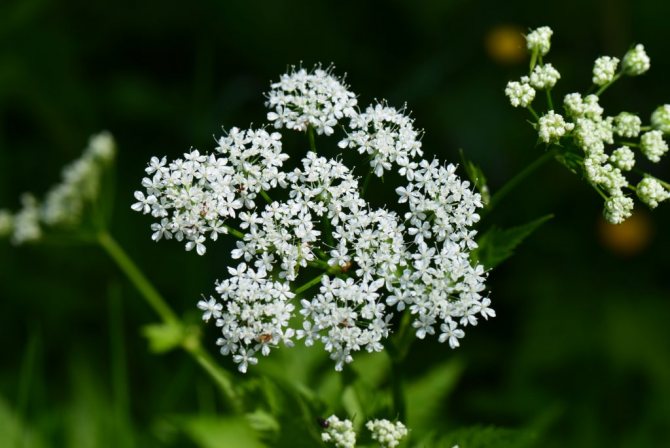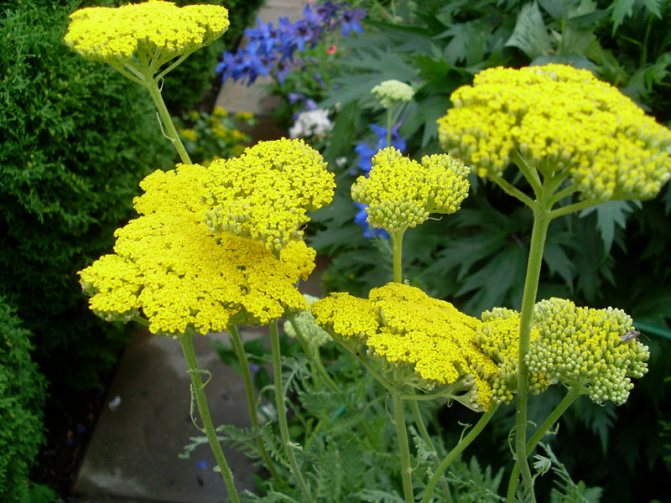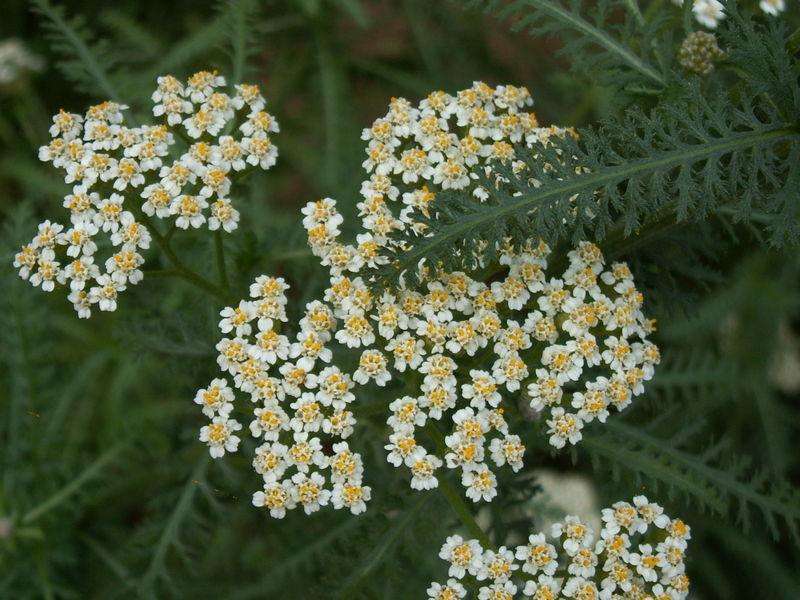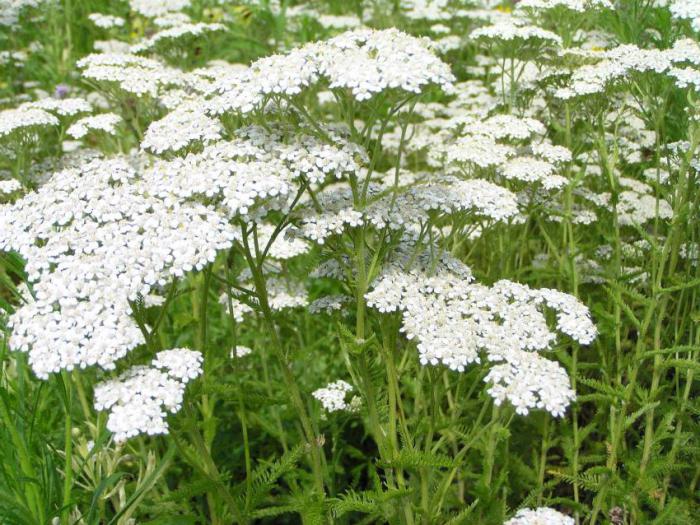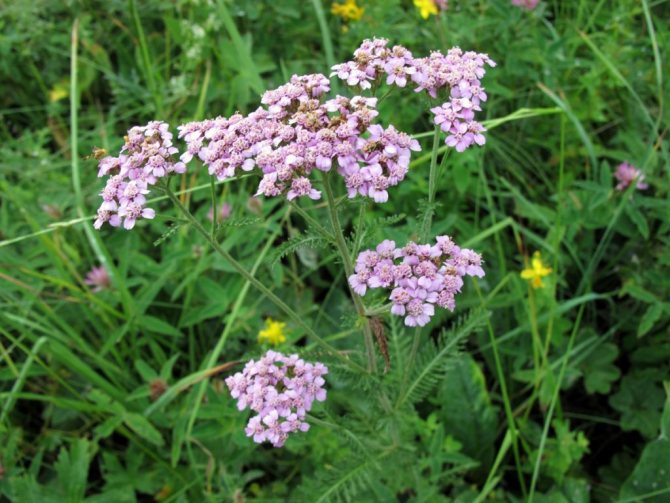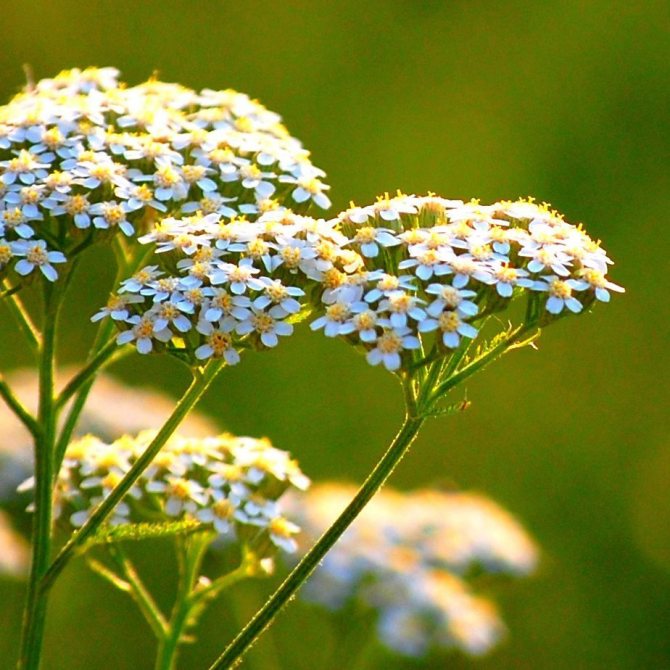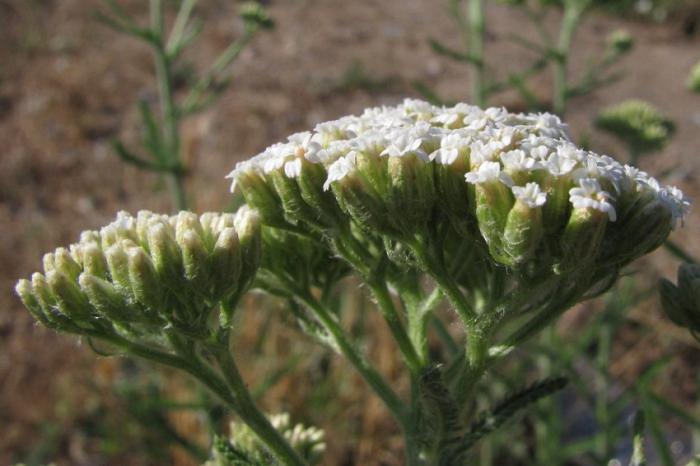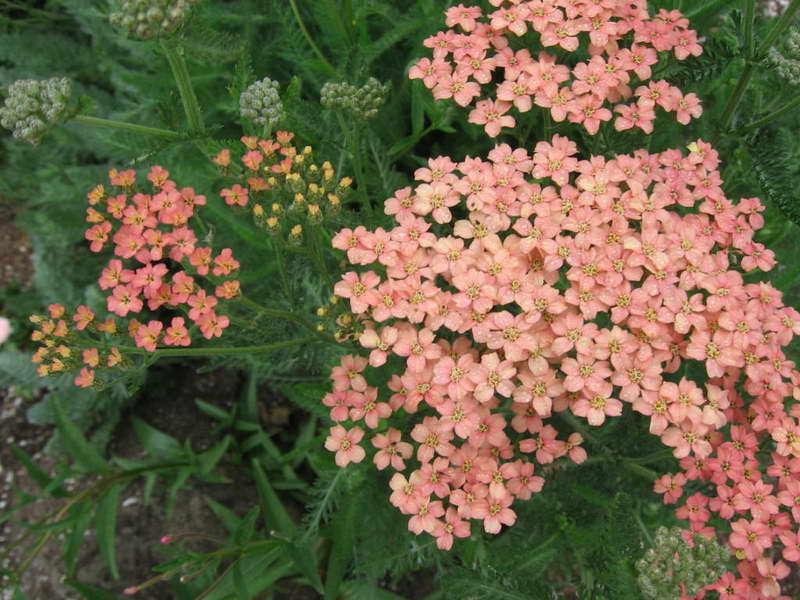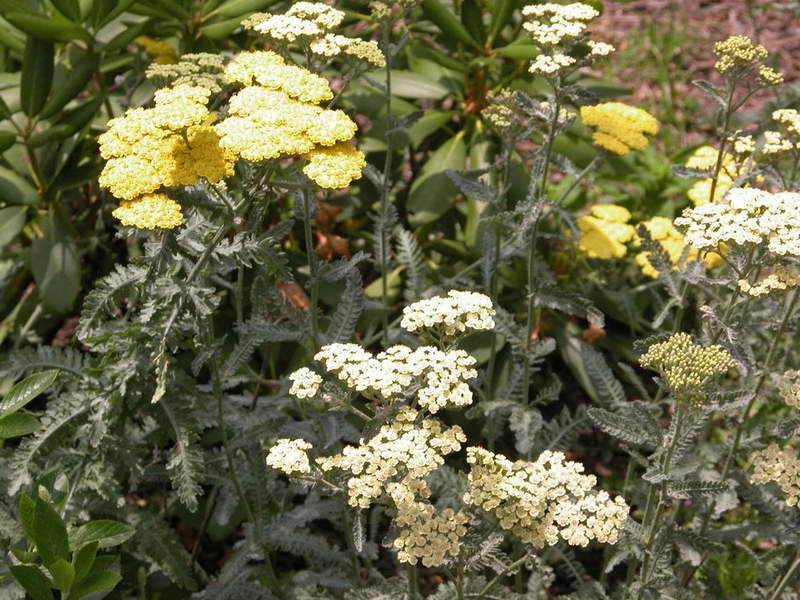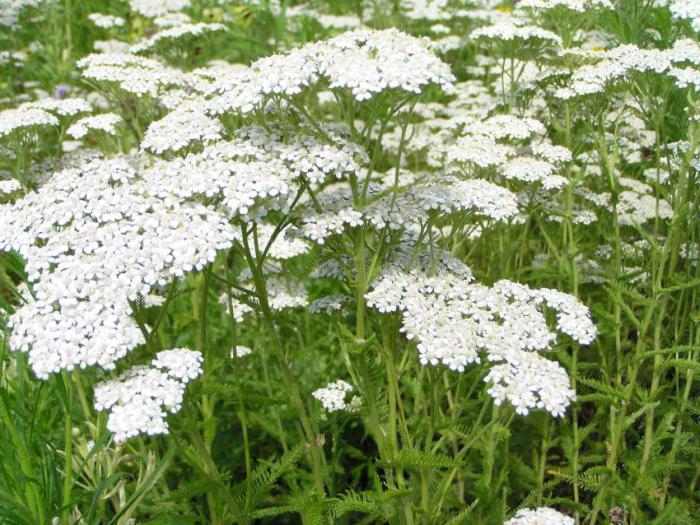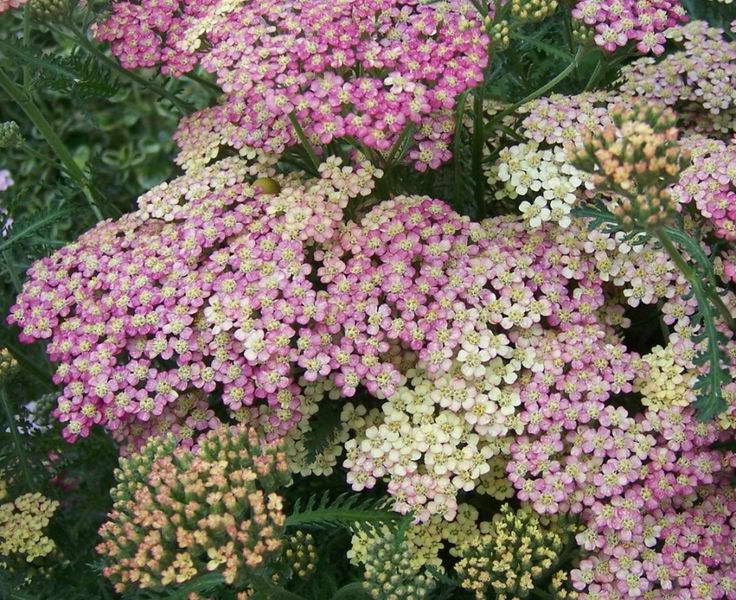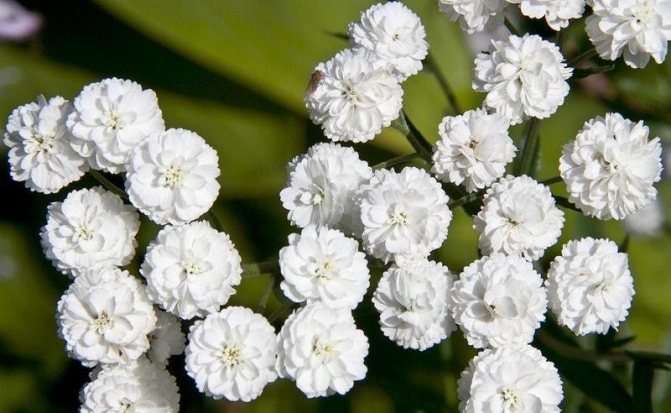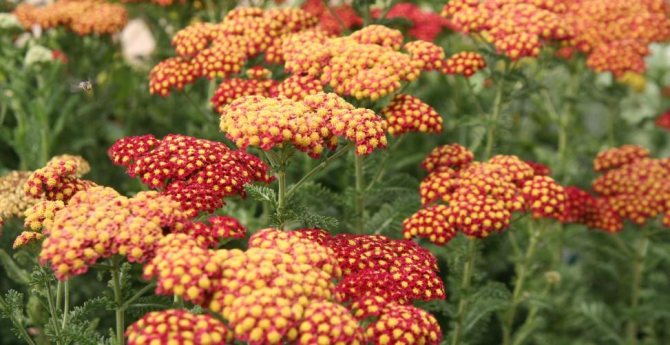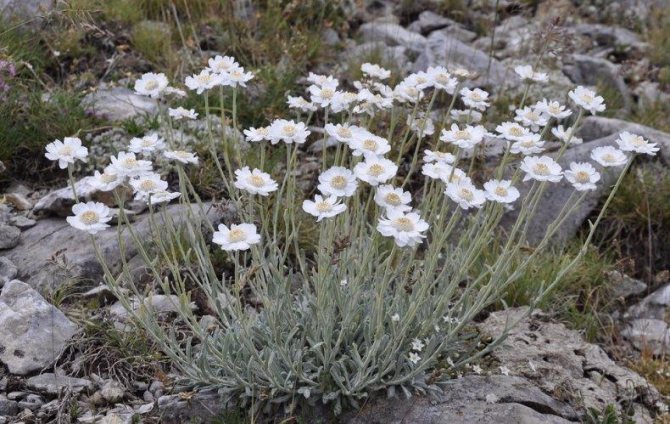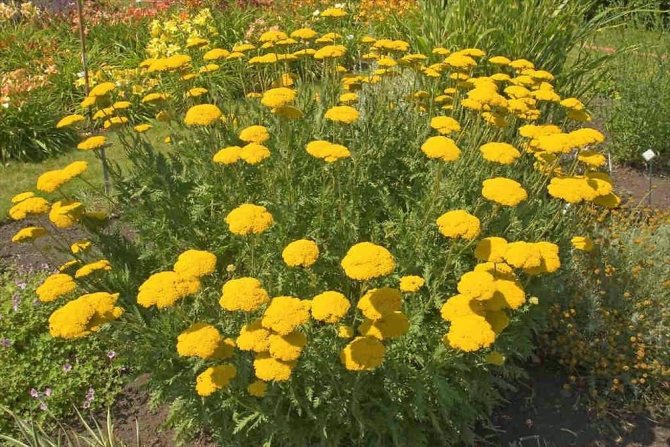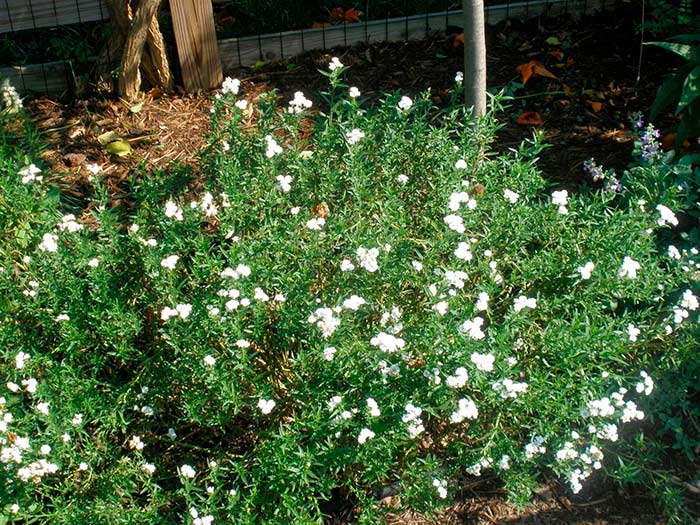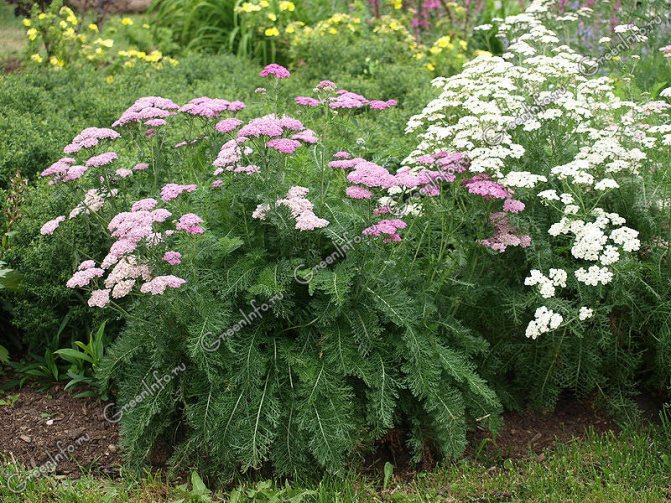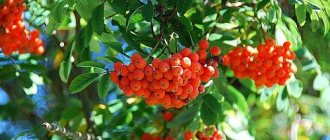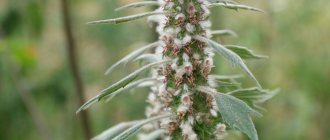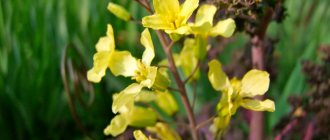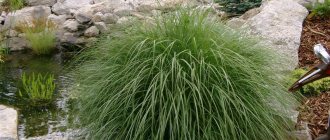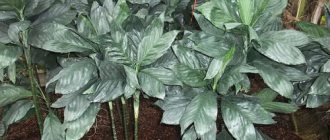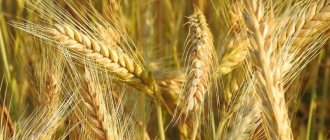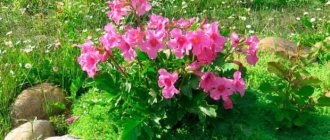Grass grows in almost every yard, the leaves of which are long and fluffy, like feathers. Then umbellate inflorescences of a pinkish or whitish hue appear. Usually children from them make wreaths, bouquets and call the grass "fish" (because of the structure of the leaf, which resembles the skeleton of a fish). This is the yarrow. It has medicinal properties and is often used to treat various diseases.
Grass grows in almost every yard, the leaves of which are long and fluffy, like feathers.
Yarrow: description and photo
Yarrow is a member of the Asteraceae family.
Rhizome perennial. Most often used in the garden yarrow (A. millefolium L.) and its many varieties.
There are also:
Yarrow meadowsweet (A. filipendulina Lam.) And yarrow ptarmica (A. ptarmica L.).
It is worth starting the description of common yarrow with the fact that it has been known since ancient times, since it was considered one of the most valuable medicinal plants used in folk medicine. This plant, due to its hemostatic properties, was used during the wars in Ancient Greece, whose peoples were well aware of how useful yarrow is. Its medicinal properties even became the reason for the legend of this amazing plant. According to her, Achilles used yarrow to heal the wounds of Telephus, the son of Hercules.
The Latin name for common yarrow is Achillea millefolium, which literally means Achilles' yarrow.
Russian folk chronicles mention the fact that this plant cured the nosebleeds of Dmitry Donskoy's grandson. It is due to its hemostatic property that the yarrow is popularly called the "bloodthirsty". In Russia, it was with this grass that the peasants soothed blood when cuts with a sickle or scythe.
Currently, about 150 species of this plant are known, but the most famous in folk medicine is the common yarrow or "hardy herb". In appearance, this plant is somewhat reminiscent of flowering dill.
See what yarrow looks like in a photo illustrating different varieties of culture:
Gallery: yarrow (25 photos)
Where does the yarrow grass grow and what does it look like (with photo)
Where yarrow grows, there is life, because the plant successfully hides the fruits of human activity. Yarrow grows throughout the territory of Central Russia mainly in meadows, on steppes, on small wastelands, on roadsides. Yarrow grows in gardens, settlements, parks in areas that are lighted and free from weeds. Rhizomes extend from the mother plant in all directions. New, young plants develop from the buds of these rhizomes, forming a ring growth around the mother. Therefore, in the old days, the thickets of yarrow were called witch's rings.
Spreading over large areas, yarrow covers with a green, fragrant carpet, like a blanket, and meadows, and territories changed by human activity, and rocky slopes ... Many modern inhabitants of rural settlements know how the grass of a yarrow looks like.
Above the thickets of yarrow in dry weather, a very characteristic bitter smell is felt. This smell is emitted by small inflorescences - baskets with white or pink flowers. Yarrow baskets are collected in larger dense thyroid inflorescences. Inflorescences-scutes rise above the stems of the yarrow throughout the flowering period, which begins in mid-May and lasts until July. The total number of flowers on one yarrow specimen can reach 20,000.
See what the yarrow looks like in the photo, which shows the different stages of plant development:
Yarrow varieties
There are many varieties, many of which are decorative.
Among the tall ones, the following varieties are distinguished:
- Yarrow noble. It is mainly found in southern Russia, Kazakhstan, Siberia and the Balkan Peninsula. Prefers steppes, meadows, mountain slopes, coniferous forests and limestone soil. In some places it grows on too salty soils, even if the humus concentration is very low. In height, this perennial of a grayish-green shade is from 0.65 to 0.8 m. The stem is both branched and simple. The basket is very thick. The leaves are egg-shaped. Flowering begins in June. Able to survive temperatures down to -30 ° C, but prefers warmth. This culture has been bred since the 16th century.
- Yarrow large-headed. This plant is unpretentious. It can be found on the Kuril Islands, Kamchatka and Sakhalin. The height of the stem is about 0.6 m. The inflorescences are white and large. The leaves are whole and large. Flowering begins in August. It is best to choose a sunny place for planting.
- Yarrow. Inflorescences usually appear in the middle of summer. They are yellow, white, purple and pink. Flowering lasts no more than one and a half months. The stem reaches 0.8 m in height. There are decorative subspecies among this species. One of the most popular varieties is Paprika. It differs in that flowering pleases the eye all summer.
- Yarrow Ptarmika. It is also known as the pearl mussel. It grows in European countries. It differs in that the main root has a creeping shape. The plant reaches a height of 1 m. The leaves are small. The inflorescences have a whitish pearlescent hue. Flowering lasts 1-2 months.
- Yarrow ptarmicolor. It is considered one of the best long-flowering varieties. Flowering begins in June. The plant can be found in the Caucasus. Differs in unpretentiousness and endurance. It reaches a height of 0.6 m. The leaves are small and narrow. Inflorescences are white and cream.
- Yarrow meadowsweet. Distributed in the Caucasus and Central Asia. This perennial can grow up to 1.2 m in height. The leaves are grayish-green and delicate. Inflorescences are yellow and golden. Flowering begins in July and ends in August.
Yarrow: why is it called
The name "yarrow" seems to us to be truly Russian. But this is not the case. This is a translation of the specific Latin "millefolium", literally meaning "a thousand leaves". In fact, there are much fewer leaves on the bush, not reaching up to a thousand, even if you count all the small narrow segments of the leaf, but there can be more than 20 thousand flowers. That is why it is called yarrow - its name comes from a descriptive principle.
Yarrow, by its very presence, has a beneficial effect on the surrounding plants. He is just as useful in the plant community as a good person in society. Such an amazing characteristic was given to the plant by the founder of biodynamic agriculture, Rudolf Steiner. It turns out that yarrow has an increased ability to extract sulfur from the soil and stimulate its absorption by neighbors.
Some types of yarrow are used in ornamental gardening - mainly as ground cover plants in poor, including stony, but well-soddy soils, less often for cutting into ordinary and dry bouquets.
In medicine, common yarrow (Achillea millefolium) and related species are used as medicinal plants.
Neighborhood with plants in flower beds
Mixborders are group plantings of ornamental grasses and flowers. It is in these plantings that landscape designers most often use different types of yarrows.The most popular is the pearl mussel variety, which meets all the requirements for flower arrangements.
Try to grow this modest flower in your flower bed, it will be a wonderful addition and a magnificent cut of wonderful flowers: roses, gladioli, peonies, will bring a little bit of simplicity and grace to a flower greenhouse.
Medicinal herb yarrow
The rhizome of the plant is thick, yellow in color, with many roots and underground shoots. The medicinal herb yarrow has an erect stem, weakly branching in its upper part. On a low stem, there are alternate leaves, gray-green in color, glabrous or pubescent. The leaves have oil glands on the underside. In the upper part of the stem there is an inflorescence, consisting of many small flower baskets. Baskets, small, multi-flowered, mostly collected in a common corymbose inflorescence, rarely single; marginal flowers are pistillate, ligulate, white, pink, red or yellow, median flowers are bisexual, tubular. Look at the proposed photos and description of yarrow - the knowledge gained will help to recognize medicinal herbs in any forest or in the fields:
The fruit of the plant is an elongated achene, painted in a silvery-gray color. The plant blooms from early summer to early autumn. The fruits ripen in September - October.
Note. Yarrow is decorative during flowering. It is very aggressive, so it should be introduced carefully into the flower garden. However, you should not completely abandon this plant: surrounded by its small inflorescences, roses look very attractive. The color range of modern varieties is quite diverse and includes many shades - from apricot orange, terracotta and peach to white, lilac-pink and red. The yarrows matched to the roses are harmoniously combined with large rose bushes, scrubs and climbing roses.
We suggest paying attention to such varieties of yarrow as:
Fanal, red velvet
Tutti Frutti, Apricot Delight
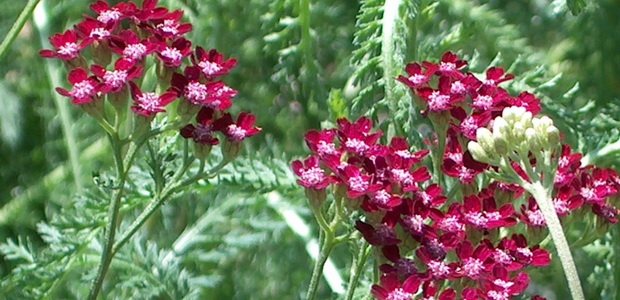
Summerwine.
Description
The Latin name of the plant consists of two words. The first is Achilles, on behalf of the hero from the ancient Greek myths Achilles. According to legend, he bathed in an infusion of yarrow, and also used it to treat wounds he received during hostilities. The second word is Millefolium. It means a thousand leaves. From this came the Russian name. Yarrow is common on all continents with the exception of Australia. Grass was also brought to this mainland as feed for livestock. Belongs to the Astrov family, belongs to the group of Compositae.
It belongs to perennial herbs. The stem is erect, round in shape. In height it can reach from 0.2 to 0.8 m, and sometimes even 1.2 m. Stems are angular and grooved. They are both naked and slightly pubescent. Branches only at the top.
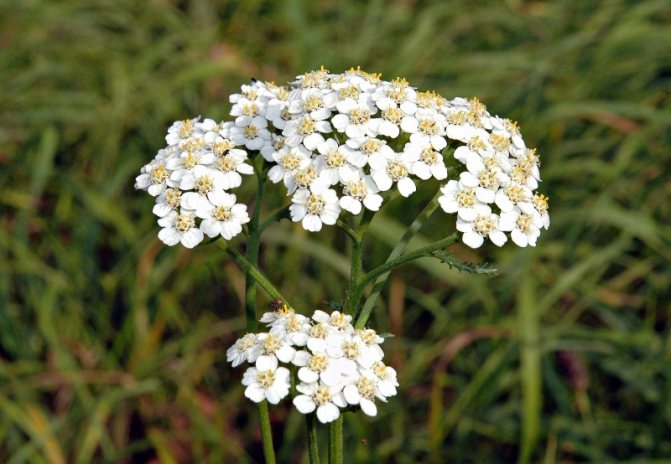

The root system is very ramified. She is dense, thick, strong. Creeping rhizome. Differs in many thin roots and shoots of the underground type.
The leaves grow up to 15 cm in length, and their width ranges from 0.5 to 3 cm. There are a large number of oily glands on the bottom of the leaf plate. The leaves are arranged alternately. Their outlines are lanceolate or linear lanceolate. On some parts of the stem, they are feathery and dissected into many segments. To the ends, the leaves pass into the thinnest sectors with a width of 0.3 to 2 mm, and end in thorns. Near the roots, leaves develop from the shoots. On the stem, they are not large, have a sedentary lowered appearance.
The flowers are small, collected in baskets that form a common shield-like inflorescence. There are female inflorescences on each basket along the edges - they are ligulate. In the middle, they are bisexual, have a tubular shape and a yellow tint. The ovary is located at the bottom. It is unilocular.
The fruit is a long, flat achene.It has no wings. Color - silver, gray. In length from 1.5 to 2 mm. Flowering begins in June and ends closer to September. The seeds ripen from July to September, depending on conditions.
Growing and reproducing yarrow from seeds
Growing yarrow from seeds in a garden plot is not a difficult process available to every gardener. Any soil is suitable for its cultivation, even the poorest and driest. But best of all, yarrow grows in sunny areas, shaded at midday, on fertile, well-moisturized soils, with good drainage and without stagnant water.
For cultivation, cultivars are used that are planted on moderately moist limestone soil. This plant has a disadvantage. It grows very much and behaves aggressively towards other plants.
Yarrow propagation is carried out vegetatively and by seeds. Most often, yarrow is propagated by spring and autumn division of the bush, by rhizome segments, and in the summer you can propagate the plant with green cuttings. Yarrow grows in one place for 5 years. When 5 years have passed, the plant needs to be transplanted to another place. To do this, the plant is dug up together with the roots, weeds are removed, the bushes are divided and planted separately. When autumn comes, the bush must be cut off, while leaving shoots that are at least 12 cm long.
Popular varieties and hybrids of yarrow
Thanks to the selection work of gardeners and botanists engaged in the development of new varieties and hybrids of plants, today there are many varieties of such a plant as yarrow.
- Pearl mussel is the most popular variety, it is unpretentious in care, has a high resistance to diseases. It is characterized by white small (up to 1 cm in diameter) flowers growing in the form of a sphere, densely and luxuriantly. The height of the bushes does not exceed 60 centimeters. It propagates, like all types of common motherwort: by dividing the bush, by root suckers, green cuttings or seeds.
- The cherry queen is a tall shrub (up to 80 cm), the color of the petals is purple, in the core there is a circle of small orange petals. Often used in multi-storey flower arrangements.
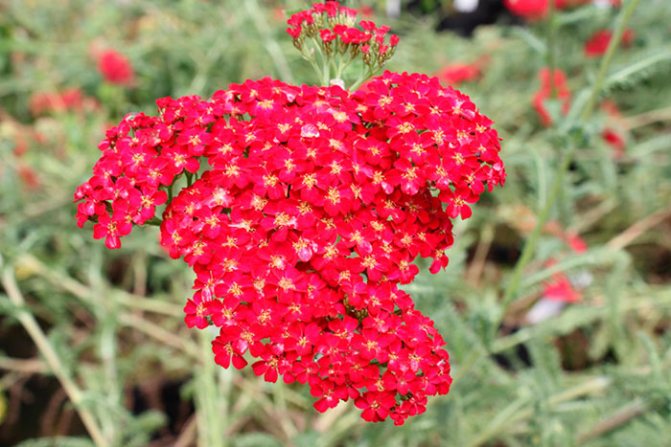

Cherry queen
- Red velveteen - it is distinguished by an unusually dense inflorescence of blue small flowers, the surface of the hemisphere resembles velveteen material, hence the name of the variety. It prefers sunny, well-lit places, while it is resistant to fading in the sun, and retains its bright color all summer long.
- Dew drop is a shrub of small height with scattered flowers (rather large), not collected in a dense basket, like in other varieties.
- Schwellenburg (meadowsweet) - also susceptible to light and sunlight, only in this case it manifests itself excellently, a very undersized bush (up to 20 cm), flowers are bright yellow, sunny in color.
Advice. When creating a flower arrangement in your flower bed, be sure to take into account the varietal characteristics of yarrow: the height of the plant, the characteristic formation of baskets and the color of flowers.
Planting and caring for yarrow outdoors
Planting and caring for yarrow in the open field does not require specific knowledge and the allocation of a large space. Everything is much simpler. You can sow the grass at any time and not worry that something bad will happen to it.
Three times a month it is necessary to fertilize the soil. The first time fertilization is applied before the flowering of the plant, the second time - during the flowering period, and the last time - after the flowering of the plant.
Yarrow in the garden reacts well to feeding - with early spring application of nitrogen fertilizers, they grow and form lush clumps. In the spring, it is necessary to carry out the formation of plants - pinch low, then the bushes will grow compact, and the flowering will be more abundant.
Varietal yarrows are easiest to grow from seeds that are sown either in early spring, after cold stratification, or late in autumn. Sowing is recommended immediately to a permanent place. In the year of sowing, the plants grow rosettes of leaves, the first flowering is observed in the second year. Flowering lasts a month and a half, then you need to cut the bushes, feed with complex fertilizers and water abundantly - flowering will repeat. Yarrow gives abundant self-seeding, and if the flowers are not removed after flowering, then the next year a perfectly flowering plant will turn into a malicious weed. Cuttings are carried out in early July. For this, young shoots are cut, which have begun to grow stiff from below. They are planted in a greenhouse with light soil and maintain high soil moisture. Yarrow belongs to frost-resistant plants; shelter for the winter is required only for young plantings. Yarrow does not get sick with diseases, it is not damaged by pests.
Dangerous diseases and insect pests
We have already mentioned that pearl mussel is not a problem plant, it almost does not get sick, it is not pestered by pests, but the proximity to other plantations can provoke both. Plant disease is treated in a cardinal way, that is, by removing infected specimens from the site. But if it is a pity to remove it, then try applying fungicides for fungal diseases, or spraying with solutions that repel harmful insects. The most effective of them are: a solution of ammonia, a decoction of garlic, an infusion of tomato and potato tops.
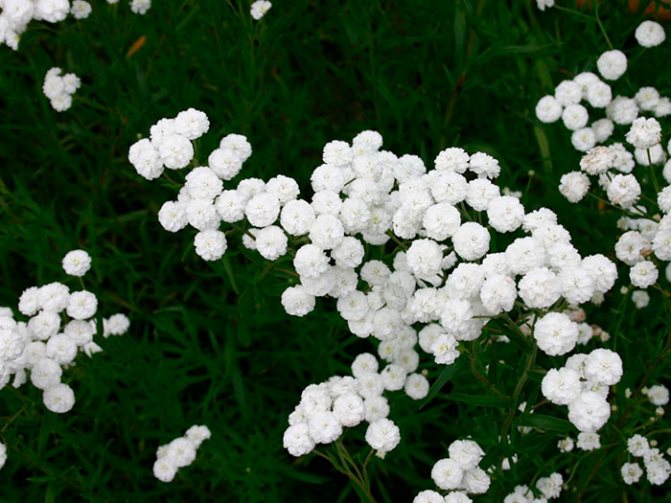

Pearl oyster rarely gets sick
Harvesting Yarrow Herb
Yarrow leaves - a medicinal raw material is a dried, pubescent leaf blades of a yarrow 5-15 cm long, grayish-green, lanceolate or linear-lanceolate, double-pinnate with linear pointed lobes. Yarrow leaves emit a peculiar aromatic odor, which intensifies when they are rubbed.
Collection of yarrow herb and harvesting: two types of medicinal raw materials are harvested - separately flowers (inflorescences) of yarrow and grass.
Aerial shoots of yarrow are cut with a sickle or knife. It is advisable to cut off the shoots in the middle of their height, or even only the tops of the shoots, because the lower part of them is very rough, its healing qualities are low. Do not try to pluck the shoots with your hands or break off, you will not succeed: the stems of the yarrow are so strong that it is easier to pull the plant out with the root system than to tear off the upper part of the shoot. In any case, plucking will lead to serious injury, if not the death of the entire plant. In addition, quality raw materials still cannot be obtained without a knife.
It is unacceptable to uproot plants, which leads to the destruction of thickets.
Yarrow grass should be harvested when flowering begins. Rough stems should not be included in the collection.
June and the first half of August are the best times to harvest raw materials.
Yarrow flowers are harvested at the beginning and in the middle of flowering, cutting off individual flower baskets without pedicels.
The inflorescences are cut, leaving no more than 2 cm of the peduncle. To remove impurities, crushed parts of inflorescences, twigs and stems, dried flower baskets are sieved through a sieve with a hole diameter of 1 mm. The stems of whole inflorescences more than 3 cm in length are pruned, the brown (faded) flowers must be removed.
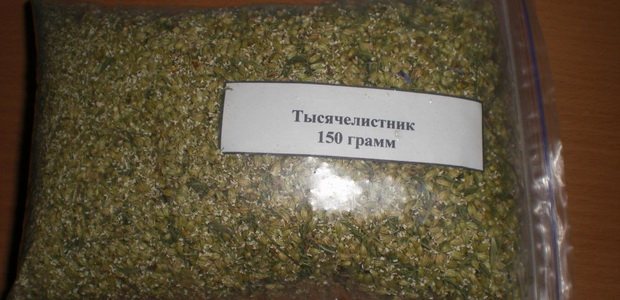

Medicinal raw materials are dried whole small flower baskets of yarrow, oblong-ovate, partially with fallen small ligulate white flowers. The middle flowers of the baskets are tubular, large, yellowish, the envelope of the basket is greenish.
Raw materials are dried under a canopy. Yarrow can also be dried in a dryer at 40-50 ° C. In good weather, the raw material dries up in 7-10 days.The end of drying is determined by the degree of fragility of the stems.
Store medicinal raw materials in a well-sealed wooden or glass container, away from odorous raw materials.
The finished raw material should have a fragrant smell and bitter taste.
Raw materials are not stored for more than 2 years.
How to collect and store raw materials
For medical use, it is necessary not only to properly grow, but also to collect and store the raw materials. Due to improper collection, preparation and storage, the medicinal properties deteriorate.
The plant absorbs all the harmful substances that are present in the environment. That is why it is forbidden to collect herbs near roads, large settlements, factories and other sources of pollution. The further the place of collection of raw materials is located from the places where human industrial activity is carried out, the better the healing properties of the plant are manifested. It is best to choose environmentally friendly areas.
In any pharmacy, you can buy ready-made raw materials for home medicines. But you can carry out the procurement yourself. If you need to prepare a decoction, infusion, tea, then experts advise to collect raw materials during the flowering of the plant. This period can begin in any summer month, depending on the type of flower and the climatic conditions in which it grows. You can harvest from July to August, and sometimes even to September.
Healing properties of the herb yarrow and their uses
In medicine, the aerial part of flowering yarrow plants (herb) is used. It contains essential oil (up to 1%), alkaloids Achillein and stachydrin, vitamin K, ascorbic and other organic acids, choline, carotene, bitter and tannins, trace elements. The herb yarrow contains a large amount of organic acids, resin, vitamin C, K and (3-carotene.
The presence of essential oil and bitterness makes it possible to classify yarrow by its medicinal properties as aromatic bitters used as a gastric remedy to stimulate appetite, in diseases of the intestines and biliary tract. The azulene-containing essential oil acts as a disinfectant, anti-inflammatory and anticonvulsant.
The high content of potassium, together with other substances, stimulates the activity of the kidneys; yarrow is used for spring and autumn treatments, mostly in mixed teas. In addition, it stops both external and internal bleeding. Yarrow tea promotes wound healing. Baths with common yarrow enhance the effect of its internal use.
Most often, the use of the properties of yarrow occurs through the preparation of an infusion, which is prescribed as a hemostatic agent for various internal bleeding (pulmonary, uterine, gastrointestinal, renal, hemorrhoidal, nasal). The strongest hemostatic effect of this herb is provided by the alkaloid Achillein.
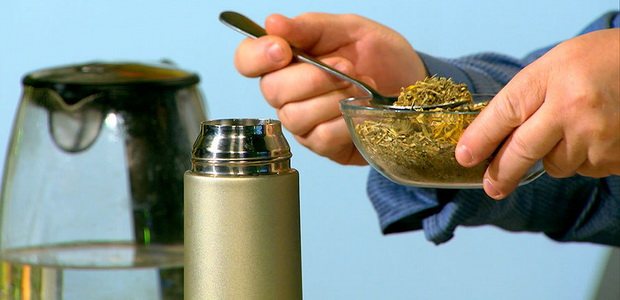

The infusion of the green part of the yarrow is no less popular as a remedy that improves the activity of the digestive organs. Its infusion is drunk to stimulate appetite, as well as for gastric ulcer and duodenal ulcer, liver disease, colitis and gastritis.
Application methods
Internal:
Bleeding - Pour 2 teaspoons of dried herbs with a glass of boiling water. After an hour of infusion, strain. Drink a quarter glass 3-4 times a day before meals.
Flatulence, bloating, stomach pain - pour a teaspoon of raw materials with a glass of boiling water, let stand for 15 minutes over low heat. Insist 1 hour, drain. Drink half a glass 2-3 times a day for 30 minutes. before meals.
Outside:
Furunculosis - fresh juice, squeezed from leaves crushed into gruel, mix with olive oil in a ratio of 1 to 10. Apply bandages to the affected area.
Hair loss - Rub fresh juice into the scalp 1-2 times a day for 2 weeks.
Psoriasis, pelvic pain - baths (100 g of dried raw materials per 20 l.hot water).
What is yarrow herb used for?
Yarrow herb has blood-purifying properties, removes toxins and toxins from the body, in this regard, the herb is indicated for all skin diseases, especially furunculosis. The cleansing properties of yarrow and its ability to improve metabolism make this herb an indispensable remedy for atherosclerosis and obesity. There are many indications for which the yarrow herb is used for various pathologies in the human body.
Tannins (tannins) contained in yarrow have a bactericidal, astringent and anti-inflammatory effect; phylloquinones increase the strength of capillary vessels, accelerate wound healing. Yarrow contains various essential oils that give the herb anti-inflammatory, antiviral and antimicrobial effects.
The effect of yarrow is also beneficial to the cardiovascular system, its decoction helps to lower blood pressure and improves venous circulation. Also, this plant is used for thrombosis, varicose veins, hemorrhoids.
Watch how yarrow is used in the video, which shows the process of harvesting raw materials and processing them into medicinal forms:
Yarrow partners
In the garden, the herbaceous perennial fits well into garden compositions. There are many use cases. This allows a wide range of colors and different stem heights of varietal varieties.
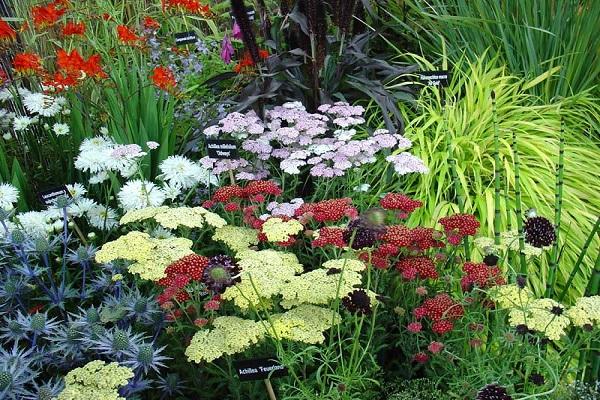

Sage can be considered an ideal neighbor. This culture is also unpretentious and retains decorativeness for a long time. Against the dark background of sage, bright inflorescences look especially bright.
A varietal perennial is planted next to sun-loving, flowering plants. The color of the flowers does not matter. Suitable neighbors are decorative tall cereals, rudbeckia, catnip, lavender.
All types of perennials have special properties. They enrich the soil with sulfur. This must be taken into account when choosing neighbors. Ornamental crops that respond well to sulfur compounds are worth planting next to it.
Benefit and harm
The healing properties and contraindications are varied. They are due to the chemical composition, which includes various elements. The aerial part is rich in flavones, coumarins, resinous substances, tannins, and organic acids. The plant contains the alkaloid Achillein. The composition contains aconitic, ascorbic acid, asparagine, inulin, choline, carotene, phylloquinone, and mineral salts. The seeds contain up to 20% fatty oils. Leaves and inflorescences contain essential oils (up to about 1%). They have a bluish and yellowish green hue.
Yarrow is also called bloodstone, sickle cutter, woodcutter. These names are associated with its ability to stop bleeding and heal wounds. In the old days, a leaf was applied to the nose to stop bleeding.
Another plant is popularly called whitehead, consumptive grass, soldier-grass. Its application is very diverse. Infusions based on leaves, stems, inflorescences are used for rashes, skin ulcers, hemorrhoids. Dried and rubbed leaves are used as a powder for abrasions and cuts. This speeds up healing. It is also suitable as a hair rinse; this home remedy will prevent baldness. As a poultice, yarrow is used to treat skin diseases, but it is recommended to consult a doctor first.
For internal use, it is prescribed in the following cases:
- as an anesthetic;
- to stop bleeding (internal);
- to enhance the outflow of bile;
- to improve appetite;
- as a diaphoretic;
- to relieve coughing, as it has expectorant properties and improves the output of sputum;
- as a sedative;
- as a diuretic medicine;
- as a substance that stimulates menstruation.
Still fresh leaves are allowed to be used for toothache. They also help with migraine attacks.The plant parts contain flavonoids. They promote the expansion of blood vessels in the periphery and help to cleanse them.
This herb heals various ailments. It is considered potent, so you need to be very careful with its use. The dosage must be observed and not exceeded.
It is forbidden to use medicines based on yarrow if an individual intolerance to this plant or certain substances that make up it is found. Otherwise, the patient may develop an allergic reaction in the form of a skin rash, especially if fresh parts of the plant are applied. With prolonged use, an increased light sensitivity of the skin appears.
It is recommended to take funds in courses, periodically taking breaks. Otherwise, dizziness appears. If a too concentrated solution is taken orally, it can cause heartburn, especially if a person has an acidic stomach.
Contraindications for admission:
- pregnancy, as it can cause uterine tone, which will lead to miscarriage and internal bleeding;
- lactation period;
- blood clots and blood vessel disease.
The main methods of breeding yarrow
The pearl oyster is propagated in four ways:
- Division of the bush. In this case, an adult plant (5-6 years old) is completely dug up, a well-developed rhizome is divided into parts, and 2-3 shoots are left in each. In the spring, the seedlings are immediately planted in a new place, in the fall, the shoots are pruned at a height of about 12 cm.This method can be used more often, once every 3 years, this has a beneficial effect on the state of the plant, rejuvenating its root system.
- Root layers. Part of the rhizome of the mother bush, about 15 cm, is cut off in the fall and planted in a prepared area. Planting depth is no more than 12 centimeters.
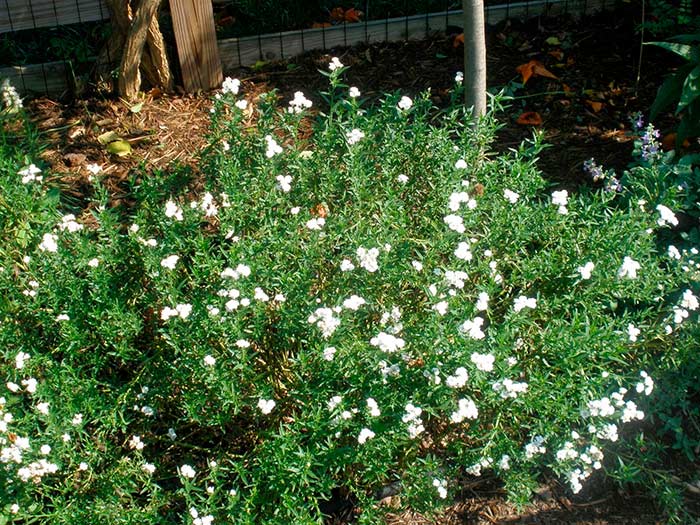

There are 4 ways to breed pearl mussels - Cuttings. It is carried out in the middle of summer, when young branches begin to grow stiff, they are cut into several parts, leaving an upper and lower bud on each, the flowering part is removed. The cuttings are soaked in a growth-stimulating solution for 12 hours, then planted in seedling containers or on a new flower bed, after moistening the soil.
- Seed reproduction. This process begins in early spring, in mid-March - early April. Seeds are sown in boxes with a substrate containing 1 part of land and 1 part of river sand. Sowing depth up to 2 cm. Watering should be done carefully so as not to accumulate seeds in one place. Use a spray bottle for this. Seedlings will appear on the 10-12th day, now you can dive them or transplant them into separate pots.
Yarrow Achillea millefolium L.
(white gruel, goulavitsa, bloodstone, hardy grass, Achilles, goose tongues, cricket grass, Jewish grass, tile grass, sheep's tongue)
The materials of the article are taken from open reference sources, are for informational purposes and do not replace a doctor's consultation.
Description:
Perennial herb of the Compositae family, up to 80 cm high, with a strong3 odor. The rhizome is thick, creeping, cordlike, yellowish, with numerous roots and underground shoots. Stem (sometimes somewhat) straight, angularly grooved, glabrous or slightly pubescent, simple or slightly branched in the upper part. The leaves are alternate, double- or triple-feathery-dissected, gray-green, glabrous or pubescent, on the underside there are many oil glands. Basal leaves are long-petiolate, stem leaves are sessile. Inflorescence - small, numerous oblong-ovate baskets, collected in multi-flowered shields on the tops of the stem and its branches. Marginal flowers are single-row, 5-7 each, ligulate, pistillate; median - tubular, bisexual. The calyx is missing; corolla white, pinkish or violet-pinkish.Fruits are flat, oblong, silvery-gray achenes. Blossoms in June - September; fruits ripen in July - October. One plant produces up to 26,000 seeds. Propagated by seeds, rhizomes, layering and is able to displace other plants from the occupied area. Ecology:
Distributed everywhere, with the exception of the northern regions of Siberia and the Far East, desert and semi-desert regions of Central Asia. It grows on fresh sandy loam and loamy soils along forest edges, clearings, glades in thin forests, along roadsides, on wastelands, in parks, gardens, forest belts, young fallow lands, settlements. Yarrow is not very soil demanding, but does not tolerate shading well.
Using:
Yarrow is often mentioned in the myths of Ancient Greece, and even its generic Latin name Achillea - Achilles open. According to legend, Achilles, the hero of the Trojan War, used this plant to heal wounds. Dioscorides called yarrow “wound herb” and used it to stop bleeding from wounds.
Galenic forms of the plant have an antispasmodic effect on the smooth muscles of the intestines, urinary and biliary tract, and therefore expand the bile ducts and increase bile secretion into the duodenum, as well as increase urine output and can relieve pain caused by intestinal spasms. Due to the bitter taste of Achilles, yarrow irritates the endings of the gustatory nerves and increases the secretion of gastric juice.
The content of tannins, essential oil and chamazulene in the plant is responsible for the anti-inflammatory, bactericidal, anti-allergic and wound-healing properties of yarrow.
Infusion of yarrow increases blood coagulability, which is manifested in a shortening of the time of recalcification of oxalate plasma, an increase in plasma tolerance to heparin, and a decrease in heparin time. Plant preparations activate the action of fibrin, but never lead to the formation of blood clots. The hemostatic effect of yarrow is based on an increase in the number of platelets and a shortening of the time to stop bleeding. When applied topically, its preparations have anti-burn properties. In addition, the infusion of yarrow acts as an antihypertensive agent, reduces heart contractions.
Aboveground part. Infusion (inside) - for gastric ulcer and duodenal ulcer, ulcerative colitis, acute and chronic dysentery, hepatitis, cholecystitis and angiocholitis; infusion and decoction (more often in a mixture with other herbs) - for nephrological and urological diseases accompanied by hematuria (acute and chronic cystitis, urethritis, glomerulonephritis, pyelonephritis, kidney tuberculosis, etc.), for uterine bleeding due to fibroids, inflammatory processes and endocrinopathies , with nosebleeds, hemoptysis due to tuberculosis, bronchiectasis. Decoction and juice (externally) - for nosebleeds, minor cuts, abrasions, scratches; in the form of tampons - for bleeding from the eroded cervix; in the form of napkins - with inflammation of hemorrhoids and bleeding hemorrhoids. In folk medicine, infusion (inside) - for internal bleeding, gastritis, cholelithiasis, diathesis, neurasthenia, hysteria, bedwetting, gastric ulcer and duodenal ulcer, as lactogenic, for the treatment of obesity, with atherosclerosis; externally - for washing bleeding wounds, ulcers, rinsing the mouth with bleeding gums; in the form of enemas - with bleeding, inflamed hemorrhoids; for washing the face - with acne. Decoction (in the form of baths) - for eczema, scaly lichen, scabies. Juice (inside) - for anemia, as lactogenic; as a means of preventing the formation of kidney and liver stones; as a hemostatic for internal bleeding, including nasal, uterine, pulmonary, gastrointestinal.It normalizes menstruation and relieves pain during them, helps with palpitations, flushing and dizziness with menopause. Juice with honey - as a general tonic, for liver diseases, to improve metabolism. Mixed with other herbs - for the treatment of gastritis and gastric ulcer. Outwardly mixed with olive oil - for furunculosis, cutaneous tuberculosis, profuse hair loss. Fresh juice - in the treatment of fresh and long-term non-healing wounds, ulcers, boils, fistulas. It is part of appetizing, gastric, laxative preparations.
In the folk medicine of Siberia, the herb infusion is used for gastritis, stomach and duodenal ulcers, for malaria and as a diaphoretic. In the folk medicine of Karachay-Cherkessia, a decoction of the herb is used for heart diseases, stomach diseases and as an expectorant, and the herb infusion is used for malaria. In Germany, the herb and roots of the plant are used for medicinal purposes in diseases of the gastrointestinal tract, as an increase in appetite, in female diseases, to stop bleeding and complaints associated with the menstrual cycle, especially in spastic menstruation and climacteric disorders. As Dr. P. Tice writes, “Yarrow is good for hardy women who hide and ignore their ailments rather than dramatize them. They do their duty even when they are in pain and only complain when things are really bad. " In Poland, yarrow preparations are widely used for diseases of the gastrointestinal tract. In France, yarrow herb is used as a tonic, diuretic, aphrodisiac, for general weakness, nervous diseases and painful menstruation. In Greece, because of the hemostatic effect, it was called the "soldier's plant". In Mongolia, the aerial part of the plant is used for tumors. Infusion of leaves and inflorescences - externally for bruises, wounds, burns. In Tibetan medicine, yarrow is part of complex medicinal mixtures used for chronic diseases of the gastrointestinal tract, as well as for intoxication. In Chinese medicine, the leaves and seeds of the plant are used as a stomach tonic. In Bulgarian medicine, a decoction of the leaves and flowers of yarrow is used as a means to stimulate appetite for anemia and lack of appetite, for hemorrhoids, scrofula, skin rashes, rheumatism, malaria, pain in the stomach and intestines, for diarrhea, as an expectorant, for inflammation of the bronchi, for the regulation of menstruation, with diseases of the liver and biliary tract, antihelminthic, with headaches. In India, yarrow is part of the drug "Liv 52".
Contraindications:
It is not recommended to take preparations of yarrow with increased blood clotting, a tendency to thrombosis. The sap of the plant is contraindicated during pregnancy. Internal use of yarrow as a poisonous plant requires caution. Long-term use of the plant and taking large doses causes nausea, dizziness and skin rashes.
Chemical composition:
The plant contains the alkaloid achillein (0.05%), vitamin K, sesquiterpenes, polysaccharides, tannins. The leaves and inflorescences contain essential oil. The highest content of essential oil is found in baskets and inflorescences, where it ranges from 0.1 to 1.7%, depending on the time of collection, the phase of plant development and other factors. In the leaves, its amount varies from 0.07 to 0.4%. The essential oil contains homazulene, camphor, borneol, camphene, menthol, alpha-, beta-pinene, limonene, 1,8-cineole, bornyl acetate, terpineol, isovaleric acid and esters (10-13%), thujene, formic, acetic and isovaleric acid, alcohols (20.1%). Of the greatest importance is homazulen, the maximum amount of which was obtained from the inflorescences in the budding phase, and from the leaves in the flowering phase, but in the leaves it is 7 times less.The amount of homazulene ranges from 0 to 170 mg% (in terms of air-dry raw materials), which is associated with plant polymorphism at the cytogenetic level, diploid and especially tetraploid individuals contain sesquiterpene lactones, 8-angeliconartabsin, which are easily converted into homazulene when processing raw materials with steam acids and alkalis, while hexaploid individuals contain other sesquiterpene lactones that do not form homazulene under similar conditions. In addition to the essential oil, basic substances were isolated from the inflorescences and leaves: betanicin (achillein), betaine, sesquiterpene lactones (acetylbalchanolide, achillilicin, millefin (achillin), apigenin, artemitin, etc.), sterols (sitosterol, campesthein, al beta-amyrin, taraxasterol, taraxasterol), saponins, tannins, polysaccharides (4.1%), resins, organic acids, vitamins C, K, carotene, gums, flavonoids, a large amount of trace elements - copper, molybdenum, zinc, concentrated by the plant ... Blanks:
For medicinal purposes, the herb is harvested, as well as the flowers of the yarrow. The grass is harvested in the flowering phase, cutting off the leafy tops of the shoots up to 15 cm long with sickles, knives or secateurs, without the coarse, leafless stem bases. When collecting inflorescences, shields with peduncles are cut off no longer than 2 cm. Areas where yarrow grows abundantly or forms thickets can be mowed with braids and then choose yarrow grass from the mowed mass. Raw materials are dried in the open air in attics, as well as under awnings, spread out in a layer 5-7 cm thick, and periodically turned over. Dry in dryers at 50 ° C. The shelf life of raw materials is 2 years. The raw material has a fragrant, peculiar smell and bitter taste.
Recipes:
Infusion of herb yarrow (Infusum herbae Millefolii): 15 g (2 tablespoons) of raw materials are placed in an enamel bowl, pour 200 ml of hot boiled water, cover with a lid and heat in boiling water (in a water bath) for 15 minutes.


It is cooled at room temperature for 45 minutes, filtered, the remaining raw material is wrung out. The volume of the resulting infusion is brought to 200 ml with boiled water. The prepared infusion is stored in a cool place for no more than 2 days. Take in a warm form for 1 / 2-1 / 3 cup 2-3 times a day 30 minutes before meals as a hemostatic agent.
Liquid extract of yarrow (Extractum Millefolii fluidum) is taken 40-50 drops 3 times a day.
Yarrow juice is harvested in July - August from the grass of a flowering plant. Take from 1-4 teaspoons to 1/3 cup 3 times a day before meals.
Fresh juice: a) to improve appetite, it is recommended to mix fresh juice with honey (to taste) and take 1 teaspoon 3 times a day; b) with neuroses of the heart, a mixture of fresh yarrow juice and rue is prescribed, 2 drops per glass of wine or vodka, drink in 2 doses per day. Outwardly, fresh juice is applied to the wound surface. Ointment - 1 g of tincture for 4 g of petroleum jelly or a handful of fresh or crushed leaves and flowers are mixed with an equal volume of unsalted pork lard; Powder from leaves of yarrow and nettle - 0.15 g each - 3 times a day as a hemostatic and anti-inflammatory.
Recipe for making herbal tea from yarrow: pour 2 teaspoons of the top of the herb with 1/4 liter of boiling water and strain after 15 minutes. Drink 2-3 cups a day mildly warm.
Note:
Infusion and decoction are used as an insecticide in the fight against various pests of agricultural crops. It is used in veterinary medicine. An admixture of yarrow contributes to the better digestibility of hay. Honey plant.
Decorative, looks good in rabatkas, borders, group plantings against the background of a lawn and ornamental shrubs. Varieties with different colors of flowers were bred: Sariz Queen with cherry-red, Kelway with dark cherry-red, Sammetriz with carmine-red, Rubrum with cherry flowers.
Fresh flowers, shoots and leaves are used as food for salads, vinaigrettes, side dishes. Dried flowers and leaves are added for flavoring in drinks, kvass, mousses, jellies, compotes, jelly, bakery products. Used as a seasoning for meat, fish, vegetable, cereal dishes. In the cuisine of European countries and the United States, potato and vegetable soups, green beans garnish, goulash, game in their own juice, vegetable dishes, gravies, and cheeses are flavored with a plant. The aboveground part is used in the manufacture of bitters and liqueurs.
The norm for laying a yarrow is no more than 0.5 teaspoon for 4 servings, since the plant contains bitterness.
Yarrow salad.
Add chopped green onions (25 g) and young yarrow leaves (5 g) kept in boiling water for 1 minute into sauerkraut (150 g). Stir and season with vegetable oil (10 g).
Yarrow seasoning.
Grind the leaves and flowers of the yarrow dried in a ventilated room in a mortar and sift through a sieve. Use to flavor meat dishes.
Meat soup with yarrow.
3-5 minutes before the soup is ready, add yarrow powder to it for flavoring. Likewise for roasts.
Borscht with yarrow.
In salted meat broth or water (500 ml), boil carrots (70 g), beets (100 g), cabbage (100 g), potatoes (25 g), onions (50 g). 3-5 minutes before readiness add chopped blanched leaves or powder (10 g) of yarrow, season with sautéed carrots and onions. Before serving, put a hard-boiled egg, sour cream (25 g) in plates, sprinkle with dill and parsley.
Mogilev style sausages.
Pass beef meat (300 g) and bacon fat (150 g) twice through a meat grinder, add yarrow powder (20 g), salt, black pepper, garlic (5 g), mix thoroughly. Form sausages from the mass, breaded them in breadcrumbs (15 g), place in a preheated, greased frying pan, grease with an egg and bake in a hot oven.
Meat in Belarusian.
Fry well-beaten, breaded meat (300 g), then simmer with water and oil (20 g) over low heat until tender. At the end of cooking, sprinkle with powder (5-10 g) or leaves with flowers (20 g) of yarrow.
Yarrow drink.
Dip the dried herb of yarrow (20 g) into boiling water (3 l) and cook for 5-10 minutes, leave for 2-3 hours. Strain, add cranberry juice (2 cups) and honey (1 cup), then stir and bottle ...
Description of the plant
What does yarrow look like? Outwardly, the flowers are quite attractive. The inflorescences are large, have a white-cream shade. The stem is hard and difficult to pick. The leaves are elongated, deep green in color with cut edges. A distinctive feature of the herb is its persistent and rather pungent odor.
Important! In addition to the usual yarrow, which is widespread in the wild, many ornamental plant species are used, grown to decorate gardens and summer cottages.
Photo
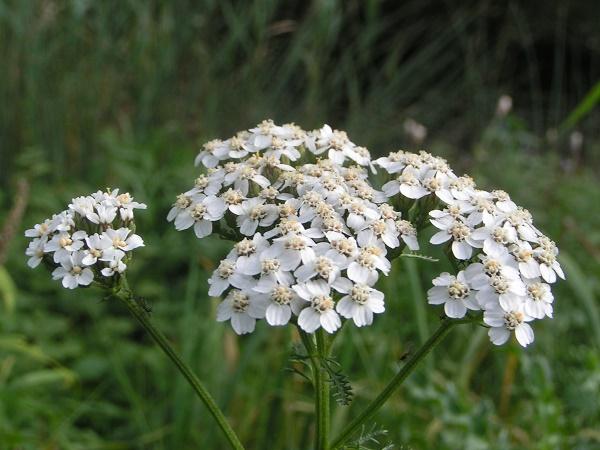

Yarrow decorative in landscape design
Yarrow is decorative throughout the season: in early spring, greenery appears, which does not fade even with the onset of cold weather; in summer, the bushes are abundantly covered with bright inflorescences.


Yarrow in a mixborder photo of flowers
Plant yarrows in clusters using different color shades. The combination with veronicastrum, crocosmia, ratibid, zinnias will be beautiful.


Yarrow Achillea ageratifolia photo with other flowers
Low-growing varieties can be planted as ground covers, framing curbs, decorating lawns, lawns. Tall ones look good in mixborders, alpine slides, rocky gardens.
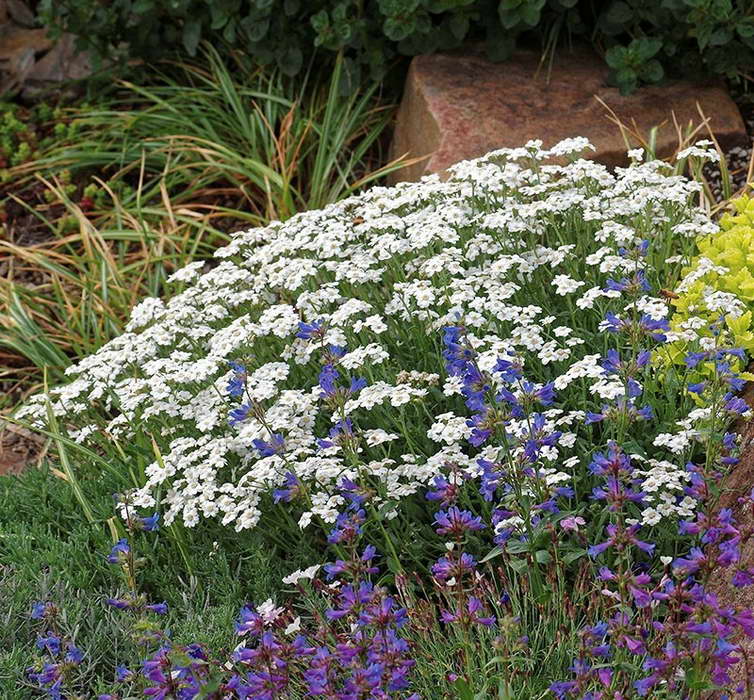

With what to plant a white yarrow photo of flowers in the garden
Ornamental grasses, plants with silvery color of leaves (Veronica gray, wormwood) will be good neighbors.
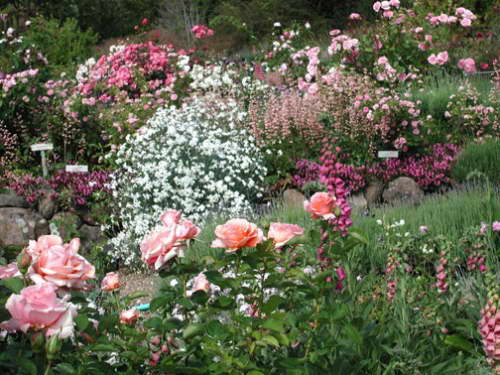

Yarrow combination with other flowers photo
Combines with herbal cloves, bells, lavender, ayuga, catnip, sage, buzulnik, liatrix, foxglove, vicha, garden roses, delphinium.
Reproduction
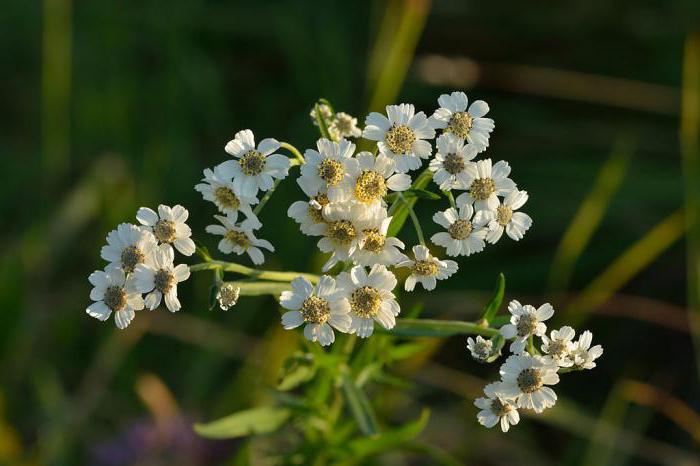

Ptarmica yarrow is able to reproduce in several ways:
- seed method;
- cuttings;
- division of the bush.
The first method is considered the most popular, with the help of seeds. Firstly, this is the cheapest option, and secondly, this method is available for use even by a novice gardener. When you already have an adult yarrow on your site, you can propagate it by cuttings and dividing the bush, but at the very beginning we advise you to use the seed option.
The chemical composition of grass trees
The composition of millefolium is quite rich, due to which it has a good effect on the body as a whole and on specific organ systems. It is reliably known that yarrow juice contains:
- essential oils (mainly in flowers and leaves): they have a disinfectant effect;
- organic acids (salicylic, acetic, formic, isovalerian): anti-inflammatory;
- vitamin K: it promotes blood clotting processes and also nourishes the bones;
- vitamin Cparticipating in metabolic processes and improving immunity.
The composition of the juice also includes esters, camphor, carotene - they are involved in the metabolic process and strengthen the body.
Growing on the site
The plant is not demanding on heat and moisture, it prefers open, sunny places. It grows well on loamy, but not over-acidified soils.
If desired, yarrow can be grown in a personal plot: there will always be a valuable medicinal plant at hand, pleasing the eye with modest beauty. He is not very demanding on soils, he loves open sunny places.
The site for planting is being prepared in the fall. The soil is dug to a depth of 15-20 cm and 30-40 g of superphosphate, 10 15 g of potassium salt, 10-15 g of ammonium nitrate per 1 m2 are added.
During the survival period, the plants are fed with ammonium nitrate or complex fertilizer at the rate of 15–20 g per 1 m. During the growing season, the site is kept in a weed-free state, the soil is loosened several times per season. Autumn loosening of the site is combined with fertilizing with mineral fertilizers. In one place cultivated for no more than 5 years. When propagated by seeds, the crop is harvested from the 2nd year, when planting rhizomes - from the 1st year of plant life.
Reproduction
Propagated by seeds and rhizome segments.
Seeds are sown in spring in beds to a depth of 0.5-1 cm, sprinkled with humus or peat, kept in piles during the summer and winter, and rolled with a light roller. The distance between the rows is 45-60 cm.
If the seedlings are very dense, when 3-4 pairs of leaves appear, the seedlings are seated at a distance of 10-15 cm.
In favorable years and with early spring sowing, plants bloom in the fall of the same year, and in the second year of life they already bloom profusely. With summer or winter sowing, the plants bloom only the next year.
For vegetative propagation, the rhizomes of wild plants are used. Sections of rhizomes in early spring or autumn are planted at a distance of 20-25 cm from each other to a depth of 10-12 cm, with row spacing of 40-50 cm, or in a square-nested method according to the scheme 35X35 and 50X50 cm.At the beginning of active growth, it is advisable to feed the plant with ammonia saltpeter, complex mineral fertilizer or mullein infusion. The same is done annually in early spring at the beginning of regrowth. As necessary, planting is weeded and loosened.
Chemical composition
Yarrow leaves contain vitamin K, methyl betaine (0.05%), essential oil (about 0.8%), formic, acetic and isovaleric acids, esters, camphor, thujone, borneol, cineole, epigenin, luteolin, achillein, chamazulene, tannins, resins, carotene, bitterness and vitamins C and K. and alcohols;
The tops of the shoots contain essential oil, alkaloids, carotene, ascorbic acid, tannins, organic acids, resins, and choline.
Sesquiterpene lactones were isolated from the inflorescences.
Essential oil is usually bright green in color. The most valuable component is chamazulene (6-25%). In addition to it, the oil contains cineole, bornyl acetate, camphor, linalyl acetate, etc.
Tannins, essential oil and chamazulene cause anti-inflammatory, bactericidal, anti-allergic and wound-healing effects of yarrow. Achillein increases blood clotting by about 60% more than calcium chloride. The hemostatic effect of the plant is combined with the ability to enhance the contractions of the uterus.
Side effects and contraindications of yarrow
The use of yarrow should be limited to pregnant women and nursing mothers - any treatment using the herb should be discussed with a doctor.
The plant should be used with caution in any dosage form for persons suffering from thrombosis, thrombophlebitis and other diseases associated with a predisposition to increased blood clotting.
Yarrow is a real helper: it is very easy to find, it is affordable and helps to cope with a number of unpleasant diseases.
Characteristics
The plant is unpretentious and fruitful. Propagated by seeds, cuttings or dividing the bush. It can reach a meter in height, and on average it grows within 35-65 cm, while the appearance is highly dependent on weather conditions. In the rainy season, it grows in one straight stem, and in the case of a sunny, dry summer, it grows short, paniculate-branched and lush. Leaves 2-6 cm long, whole, alternate, pointed, appressed-serrate at the edges, denticles with a cartilaginous tip.
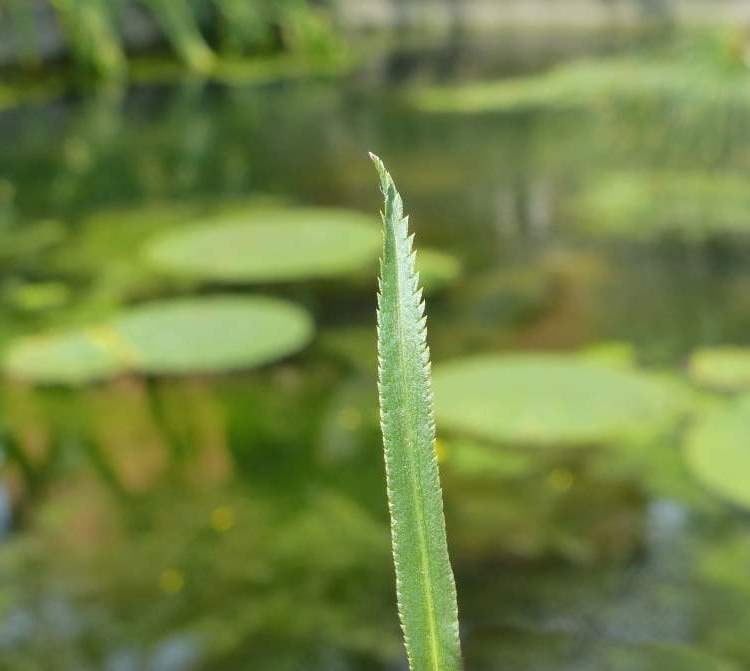

The beginning of flowering is the end of June and the beginning of July. The duration of flowering depends on the variety and can be from one to two months. Baskets in diameter can be from 10 to 17 mm, collected in apical, sparse or dense corymbose inflorescences. The testes are 1.5-2 mm long, oblong or obovate, flattened, with a truncated apex.
In natural habitat, it prefers to settle on moist soils, clay and loam in partial shade near water bodies. When growing ptarmica in the garden, it should be remembered that during high temperatures and low humidity, this subspecies is very demanding for watering, unlike its "species older brother".
One of the many advantages of yarrow is that it is able to extract sulfur from the soil in large quantities and share it with the surrounding plants, thereby having a beneficial effect on them. And its most important drawback is that it can actively capture the area on which it grows. This can be resisted by timely removal of dried inflorescences. In all other respects, this decorative yarrow is not picky about itself and will delight the eye with abundant and long flowering.
The most common variety of the decorative variety of the ptarmik yarrow is the pearl mussel, also called the pearl (The Peri) or white pearls. The conditions for planting and caring for pearl mussel, as well as its cultivation from seeds and breeding methods, are the same as for other varieties of yarrow and are described below.


Botanical description
Ornamental yarrow or Achilles is a perennial herb of the Astrov family. The height of the stem is 15-100 cm. The toothed leaf plates are arranged alternately. The color of the stems and leaves is bright green - the plant looks decorative even outside the flowering season.
During the flowering period, the bush is covered with small inflorescences collected in shields. Their diameter reaches 20 cm. The color is bright: sunny yellow, snow-white, lilac, purple, various shades of pink.
The natural habitat is extensive: fields, meadows, steppes, mountain slopes of the temperate zone of the northern hemisphere.
Yarrow has been cultivated for hundreds of years. There are species with medicinal properties. It is used for landscaping gardens, personal plots, parks.
Landing
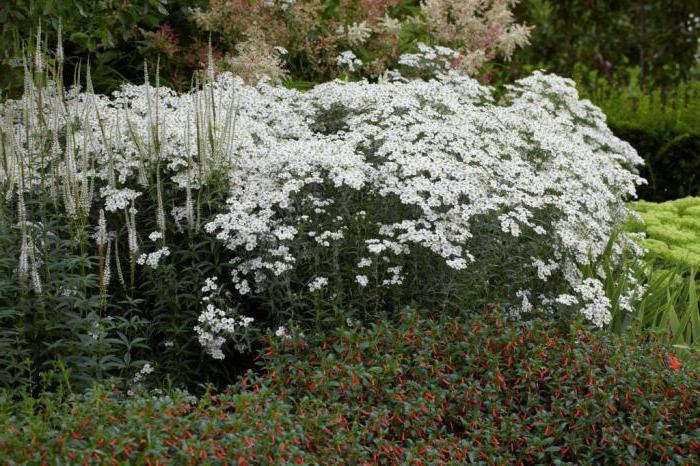

Planting of ptarmik yarrow should begin at the end of the winter period. In this case, you can speed up the flowering period. Otherwise, you will not be able to see flowers on the site soon. For a positive outcome of the whole process, it is recommended to follow simple instructions:
- Prepare the soil before planting. A mixture of fine-grained substrate and river sand is ideal.
- Take a shallow box or other container, pour soil inside. Note that this plant does not require the organization of a drainage layer.
- Place the seeds about two centimeters deep, but not deeper. Otherwise, they will not be able to germinate, and the process will fail. You need to sow seeds in rows, leaving a gap of about three to four centimeters between them.
- Moisten the ground with a sprayer. Do not use any other watering option as this may deepen or wash away the seed.
- Place the container with seeds in a warm and light place, but avoid direct sunlight.
- Cover the box with plastic or plastic that allows light to pass through, creating a greenhouse effect.
- After two weeks of waiting, you will notice the first shoots, after which they need more careful care. It will be necessary to regularly moisten the soil.
Yarrow care


Yarrow (and its other varieties) are undemanding to growing conditions. It is best to use well-lit areas for planting this plant. But if this is not possible, then in the shade, the yarrow will not experience discomfort.
The plant easily adapts to various soils, but it is best if it is a calcareous, sufficiently moist soil. In dry weather, yarrow should be watered regularly. 4 years after planting, the plant can be planted.
The breeding method of yarrow is by seeds, cuttings and division. The most common and convenient is the division of the bush. This procedure is recommended every 2 years.
The most favorable seasons are spring and autumn. In the summer, you can do propagation by cuttings. First, you should separate a small part from the yarrow bush, place in the ground and water. Seed propagation is more difficult.
The most acceptable way is to sow yarrow at home in a suitable container, and plant already grown flowers on the flower bed. If you sow the plant immediately on a flower bed, then a young yarrow can be confused with weeds.
Legend of the Yarrow


There are many legends about yarrow. Even small children knew them, not yet knowing what the yarrow plant looks like. One of the legends says that a certain carpenter Joseph often wounded his hands while working. It was this circumstance that made the man turn to the medicinal properties of yarrow. With the help of this plant, the carpenter quickly healed his wounds and returned safely to work. From the lips of Joseph, other people also learned about the miraculous herb. In those places, the inhabitants still call the yarrow "the herb of St. Joseph."
Yarrow on a backyard
|
In ornamental gardening, several types of yarrow are used, but this does not exclude the inclusion of the simplest yarrow in landscape compositions. In culture, the bushes are large and elegant with very large inflorescences. Plants can be placed on the site in a group or in a mixborder. Plants with pink flowers look especially impressive.
And the plant also has insecticidal properties, so some gardeners and gardeners use it to destroy harmful insects: aphids, spider mites, thrips.To prepare the infusion, the dried and crushed grass is poured with boiling water, infused for an hour, then filtered and dissolved in an infusion of laundry soap (a bucket of infusion requires about 1 kg of grass and 20 g of soap).
Photo: Rita Brilliantova
Decorative yarrow ptarmika "Pearl" video
[Voters: 6 Average rating: 4]
×
My Family Garden - Help
Dear friends!
In such a large assortment of all kinds of goods, it is very easy to get lost and of course you want so much! But it happens that there is no way to order everything at once.
So that you do not lose the products you like and do not waste time looking for them, we have created a convenient section for you where you can save the items you like.
Now you can create your own personal "Family Garden".
On the page of our new section, you have the opportunity to create lists, convenient for you, where your plans for future plantings will be stored. Sort products into lists by price, culture, pick-up time, any property you like.
Did you like something but want to order it later? Create a list, save the selected items there and when the time comes, click the "all items in the cart" button. The total amount of the future order will be shown in the lower right corner.
To get started, use the already created "Favorites" list, save all the positions you like to it. If you want to create a list with your own name, just click the "Add new list" button. Give it any name that will help you navigate, for example "Seeds for 2019", "My Club", "Summer Flowerbed", etc. And when the hour comes, in a few clicks order all the goods you need, for example, for your winter garden.
Now looking through the detailed description of the product, you can click the "Add to My Family Garden" button, and the product you like will be saved in the folder of your choice.
Easy, fast, convenient! Happy shopping!
How to use the My Family Garden section
To add a product to My Family Garden, you need to go to the product page.
In the additional window that appears, select the list to which you would like to add the current product. You can select New List by giving it a name. After selecting the list, you must follow the link "Ok".
My Family Garden On the section page you can view all the products you have added, as well as the created lists.
From here you can add a product to your shopping cart, individually:
And also the whole list:
You can also remove an item from the selected list:
Or clear the entire list of products:
To completely remove the list, use the following link:


Create lists on a variety of topics. Examples of names can be very different: "My future summer flower bed", "For dacha", "Apple garden" and many others. Do you know exactly what you will order from fruit and berry seedlings? So name the list "Delicious", adding your favorite varieties there. And when the time is right, order the entire list in just a few steps.
We have done everything to make My Family Garden as convenient and intuitive to use as possible!
Most gardeners, although they have heard about the healing properties of yarrow, still do not recognize it as a horticultural culture, seeing in it only wild-growing grass. Nevertheless, the decorative properties of some species of this plant are not inferior to its medicinal qualities.
Yarrow in the garden is used mainly for mixborders, group plantings, it also looks very beautiful when cut. For the formation of winter bouquets, meadowsweet yarrow is most suitable.
There are a great many species of yarrow, both natural and bred. So, among them there are tall plants growing more than a meter in height, and very small compact bushes.
Tall plants are best used for single plantings, undersized for the formation of rock gardens.
And due to its unpretentiousness to growing conditions, yarrow can be planted around group plantings, where other flowers cannot take root.
Low-growing species are also ideal for setting up a lawn or lawn in a sunny area of the garden, because these bright, colorful toddlers are extremely resistant to trampling.
And one of the main advantages of all types of yarrow is decorativeness throughout the season and extremely long flowering.
However, this flower also has disadvantages. Any yarrow is prone to weed self-seeding, and therefore will soon try to reclaim the impressive territory of your site for its descendants. In order for your garden not to turn into an exclusively "yarrow", you should carefully monitor and remove old inflorescences in a timely manner.
Any yarrow in the garden will look advantageous against the background of colossal plants (loosestrife, Vich's buzulnik, liatris), as well as in combination with plants that have silvery foliage (gray-haired veronica, narrow-leaved lavender, various). Species with yellow inflorescences will perfectly complement flower beds and flower beds with blue flowers.
In order for the yarrow to decorate your garden, you need to choose the variety that suits you.
The most popular, perhaps, one of the varieties of Ptarmik yarrow - "Pearl". Yarrow "Pearl" is a short bush, about sixty centimeters in height, decorated with white terry flower baskets. The baskets are very small, no more than a centimeter in diameter, but there are so many of them that from a distance the bush resembles a fluffy cloud.
In addition to its charming appearance, pearl mussel yarrow is also extremely unpretentious. It can grow both in a well-lit area and in a shady place. In addition, it is completely undemanding to the soil.
The pearl mussel bloom period lasts from June to October. This look will look equally good in single and group plantings.
Another, no less popular variety of yarrow is “Cerise Queen”, translated into Russian as “cherry queen”.
Quite a tall bush, reaching eighty centimeters in height. Small inflorescences are painted in a rich cherry, truly royal shade. Ideal plant for rabatki, mixborders and Moorish lawns.
It goes well with flowers of blue and purple shades, looks good against a background of silvery foliage in combination with white flowers. Also, the plant is good in cutting.
One of the more recent varieties to be bred is Red Velvet.
This yarrow is unlike any of its many cousins. The voluminous double flowers of a deep red color really resemble dense velveteen.
The ligulate flowers can be white or light pink. This species is more capricious, prefers sunny well-lit areas.
The undoubted advantage is the color fastness to sunlight. Throughout the entire flowering period, it remains bright and does not fade. It feels most comfortable on calcareous soils. This yarrow is most suitable for rockeries and mixed plantings.
No less attractive is another terry yarrow, although not so bright - the ptarmik yarrow "Dew Drop". This variety is a compact, low bush, no more than twelve centimeters in diameter. Inflorescences are large, lush, terry white, but not collected in a basket. The flowering period is from early summer to mid-autumn. This species will retain its decorative effect throughout the flowering season and will be a wonderful decoration for any corner of your garden.
A bright accent of your rock garden can be a yarrow meadow "Schwellenburg" ("Schwellenburg"). A bush no more than twenty centimeters high, tiny, like the town after which it was named. The flowers are small, sunny yellow. It is especially undemanding to the soil, it will be able to express itself in all its glory only in areas well-lit by the sun.
All species of yarrow have an absolutely amazing quality to get sulfur from the soil and distribute it among neighboring plants. Therefore, no matter what flower arrangement your yarrow complements, its neighbors in the flower bed will feel great.
Preparation of medicinal raw materials
What you need to know when harvesting this grass for the winter? Yarrow (the description of the plant makes it clear) is used in full - stems, leaves, flowers. A favorable time to collect medicinal herbs is from June to August.
Take a secateurs or long scissors. Carefully cut off the soft tops of the shoots (about 15 centimeters) with flowers. Cut the finished raw materials into pieces and lay them on a linen cloth in a shady place. Once the stems are dry and crunchy, transfer the raw material to a glass jar for storage.
Cherry queen
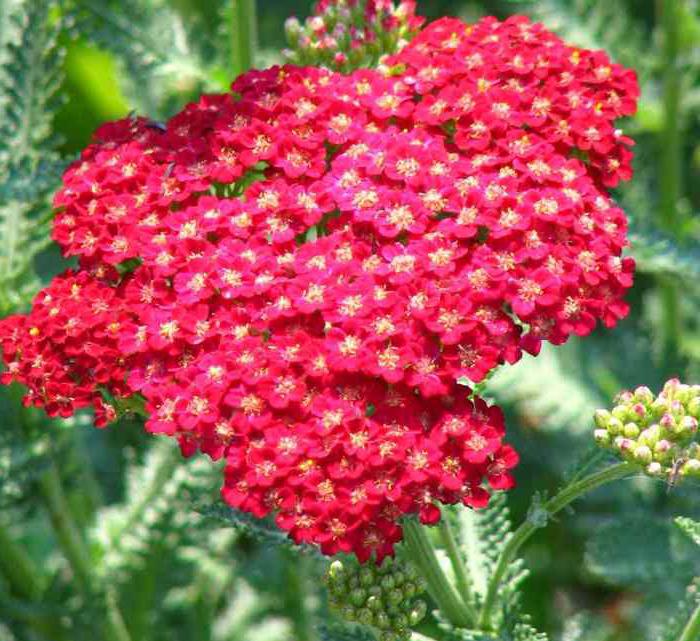

Another popular variety is the "cherry queen". Visually, it looks like yarrow, however, it is slightly higher, and the flowers are of more saturated tones. Decorators successfully use the popular type of yarrow to create a variety of lawns.
The bright flowers of the "cherry queen" are perfectly combined with blue and purple plants. Bunches of yarrow look great against a background of emerald foliage in harmony with neighboring flowers.

